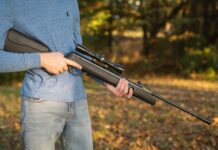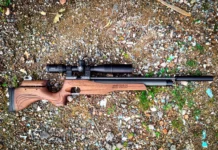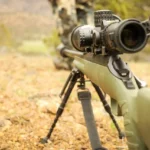Successful hunting sessions usually require you to bear the stiff North winds or endure the thick fog while paying attention to your goose spread.
The last part plays a quintessential role during any hunting expedition, and the lack of decoy placement knowledge can result in frustrating failed hunting attempts, especially if you are a novice hunter.
To bag multiple geese, hunters must utilize their hunting ground smartly while creating a foolproof strategy.
In this article, we shall peer into five of the most acknowledged decoy spreads for a successful hunting expedition.
Table of Contents
5 Best Goose Decoy Spread With Corresponding Diagrams
The following are five of the best goose decoy spreads with matching diagrams to quickly understand the spread’s structure.
We highly recommend trying all five at multiple expeditions while gauging the season, terrain, and topography of the hunting ground.
#1 Classic U-Shaped Decoy Spread
The U-shaped decoy spread is the most classic and loved spread across the United States. The main shape of the setup alongside the decoy resembles a beautiful U, giving it the corresponding name.
Its U shape helps funnel the geese directly into the middle of this design, which falls in front of the shooters.
You can alter the blind placement according to the weather and climatic conditions, but ideally, a center U blind position can funnel all the geese near the shooter.
Hunters can usually benefit greatly when the blinds are placed in the far front area or apex of the spread during strong winds. Similarly, you can place the blinds at the back of your spread design, giving birds ample time to lower their height from the ground.
We highly recommend this position when you go on a group hunting trip.
Always remember that the wind’s strength dictates your blind placement; stronger winds are ideal for upfront blinds, while low wind conditions are preferable for further back blinds.
Also, ensure that you are hiding all the blinds properly by packing multiple decoys around them. We recommend following a random decoy placement pattern instead of a 2-2 ft measured gap.
A little random spread gives a natural look that can fool and lure the geese easily.
#2 Cross Wind + Sideways U Decoy Spread
Understanding the bird’s instincts and habits shall help you hunt better regardless of the season or hunting location. You will also need your best-looking geese for this specific decoy spread, as it is highly focused on the birds’ instincts.
This decoy is a sideways U decoy mostly used when encountered by crosswinds. Remember that hunters need to bring all their baits for this spread and ensure they look natural to perform effectively.
Start placing most of the decoys around the blinds so the spot is relatively hidden. Content decoys can be equally effective when placed nearest to the blinds.
Also, it is known that geese prefer to land in the middle of a group, so using their habit for our benefit can help hunters lure the bird better.
To do that, you can place four to five active geese in the middle of the zone. Try to use your best-looking geese for this action, and it shall be your staple spread during late-season hunting every year.
#3 The Double V Decoy Spread
Our third decoy spread is the double V design that works exceptionally well in water setup for puddle birds. Another fascinating positive of this spread is its ability to attract multiple primary, secondary, and even oddball duck species.
However, hunters must understand how to lure these geese and other birds.
You can start setting your first V slightly upwards where the wind is supposedly blowing parallel to the river/pond bank. For your second set of V, arrange the decoys behind the first V at a safe distance.
We suggest opting for a reasonable 10-20 yards distance between the first and the second V.
To make the spread more natural and attract small flocks or singles, consider placing single decoys between the V at regular intervals.
Furthermore, to increase the chances of attracting more birds, create secondary decoy spreads near the blind, especially between the gap of both the Vs.
Hunters must remember that puddle ducks habitually land behind the V decoy shape instead of landing in front like most divers.
On the other hand, southern waterfowl hunters hunting in November usually have great success with this spread using a mix of green-winged teal and mallards. Even black ducks, gadwalls, and pintails work well in the location.
#4 X Decoy Spread
X decoy setup is one of the most exciting decoy spreads and usually requires a lot of space for proper execution. The blinds are always positioned in the center of the X as the decoy geese extend in four corners.
That positioning is excellent and highly lucrative with little to no wind.
Additionally, this spread is ideal for hunters who want the benefit of shooting from all directions based on the bird’s landing. If you like the freedom to attack from all directions, this X decoy spread will surely be your staple design for future hunts.
Geese, like other birds, enjoy the safety of multiple birds in one place, but fortunately, this decoy is designed to give hunters ample void spaces for the geese to get drawn into. So, when talking about X spread, hunters get four voids covering all directions.
Shooters can begin hunting as soon as they spot the first group coming towards the spread. You can either consider shooting them overhead or allow them to land and then reposition to shoot for the entire day.
X decoy spread requires double the number of the decoy compared to standard or regular setups. However, hunters usually prefer this spread during the late-hunting season with a strong strategy while using their best-looking baits.
Additionally, this spread allows shooters to utilize the decoys collected for the past few seasons. Lastly, try to mud the blinds and brush them to blend well; it can make a lot of difference.
#5 The Crop Circle Decoy Spread
This crop circle decoy setup works flawlessly even during variable and light winds. Harvested grain fields look attractive enough that geese and ducks tend to come down in any direction.
Furthermore, the circle spread allows the ducks to be in the front, making shooting them far easier. .
To create the most authentic crop circle decoy setup, you need to set up a small flock in a circle with an individual decoy in the center of the ring. The geese then target the inside edge of the ring or directly aim at the center decoy.
The most common and successful decoy has to be the mallards; however, even gadwalls, pintails, and other species can entice the geese.
Furthermore, if you spot Canadian geese near your hunting ground, consider setting up a tiny group of goose decoys far from your main circle spread. Those secondary decoys will surely provide a bonus opportunity when you miss out during the crop circle.
How Many Decoys Should I Bring To Hunt Geese?
It varies from one hunter to another. Some people suggest a modest number, while others will spurt an astonishing number of decoys. However, in our experience, we can tell that even a setup of 15-20 decoys shall work in your favor, provided you know what you’re doing.
Similarly, if you wish to opt for more baits, consider sketching our setups that work well with hundreds of lures. The X decoy spread is one such setup that works efficiently with hundreds of lures.
Apart from personal preference and spread selection, three main factors influence the number of your spread:
Hunting Season
As a general rule of thumb, hunters need to increase or decrease their number of decoys based on the season and its progression. That is mainly necessary because as time progresses, so does the size of the flocks due to migration.
Another remarkable observation passed on for centuries is the geese’s preference. Usually, flocks never land towards decoy flocks smaller than the birds flying above. Thus, the bigger the congregation, the more decoys should be shelled out for the display.
Early season hunting is possible with smaller decoy spreads as the flocks are notably smaller. An average of 15-20 decoys will be sufficient for early-season hunting.
Additionally, we recommend limiting your decoy to a smaller number even if you have access to a good number of baits.
A cluster of lures in the early season can look highly unnatural. For mid-season, keep a safe number of 25- 40 decoys as you shall notice geese migrating to multiple hunting spots.
The birds will start feeling the hunting pressure from the mid-season, so to make the flocks comfortable, hunters need to arrange decoys anywhere from 25 to 40. Lastly, late-season calls for the most significant number of bait spread hunters can set.
Geese are usually in complete migration with many birds in their flocks; therefore, we recommend decoys anywhere between 50-80+.
Shooters must remember that birds feel the most hunting pressure in this period, so luring them becomes relatively challenging. You may succeed with smaller decoy setups if the area is filled with solo birds flying by.
Decoy Type
The decoy type that you will operate ends up playing a significant impact on the quantity required. The most popular decoys consist of windsock, shells, full-body, and silhouette decoys.
Hunters who often hunt with full-body decoys can get away with small spreads featuring lesser baits as the full-body ones have the most outstanding visibility amongst all decoy types.
If you are hunting Canadian geese, oversized shell decoys can undoubtedly become your best friend in the fields. However, shooters opting for silhouette decoys need a significant number of decoys for their spreads.
Since these decoys are 2-Dimensional, hunters need to use a massive number of baits facing in multiple directions.
Hunters On The Field
The decoys on the hunting field are directly proportional to the number of hunters on the ground. You might even see hunters preferring to stick to their ‘1 hunter = 2 dozen decoys’ formula. That formula is a safe bet which ensures that every hunter’s blind is well covered.
With each added hunter, the ground needs a group of decoys to hide that particular blind effectively. If hunters set up an X or V spread, then almost every shooter wants to be at the tip of the V and in the middle of the X.
At such times, to mask the uneven bumps and hunter silhouettes, you need to use a lot of decoys. That allows the hunters to have fair and better shooting opportunities as the geese approach their respective decoy spread.
Effective Goose Hunting Decoy Spread Tips
- Hunters can successfully hunt even if they lack a massive collection of decoys. All they need is a foolproof strategy that works according to the season.
- Ensure to leave enough void for the geese to land perfectly. Decoys that clump too close together usually discourage geese from approaching the spreads. A six to eight feet gap between each bait provides ample space for the birds to land without feeling any suspicion. However, you must place a few decoys together to show a small family grouping. That call is entirely dependent on the type of spread you have chosen in the first place. We recommend using your best judgment with acute observations for a successful trap.
- Always use the wind speed and direction to your advantage. Geese are habitual to landing into the wind, so if the wind is supposedly blowing toward the west, these birds will land facing the west cutting the wind. Wind direction is crucial if you wish to bag multiple birds without losing sight of your prey.
- Try to observe and replicate the behavior of the geese. While scouting for hunting grounds, consider studying the birds and their habits. Check whether they are flying solo or are always in a group. Also, kindly pay attention to their eating, resting place, feeding time, etc. Use this information to sketch an ideal spread that shall work in your favor on the day of hunting.
Conclusion
With those tips, we have come to the end of our geese decoy spread article. We highly encourage novice hunters to use our recommendations and reliable spreads for successful hunting expeditions.
Even if a spread setup doesn’t work out, opt for another while keeping track of the errors. With some consistent trial and error, you shall be able to master the art of skillful spreads.










































